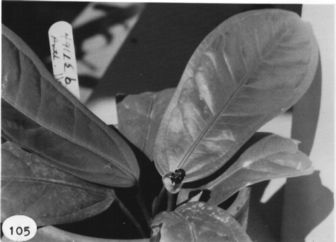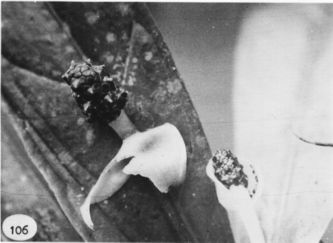





Anthurium llanoense Croat, sp. nov.
Epiphyte; stems very short, 0.5-1 cm diam.; internodes short; leaf scars 4÷6 mm wide; roots long, thin; cataphylls subcoriaceous, 3÷4 cm long, caudate acuminate at apex, drying tan, weathering into subpersistent fibers.
LEAVES spreading; petioles 1-6.5 cm long, 2-4 mm diam., sub-terete, weakly sulcate adaxially; geniculum ca. 0.5 cm long, only slightly thicker and more conspicuously sulcate than petioles; blade oblanceolate to oblong, moderately thin, short-acuminate at apex (the acumen minutely apiculate), obtuse to rounded at base, 12-28 cm long, 2.5-8.5 cm wide, usually broadest m upper third; upper surface semiglossy, lower surface matte to semiglossy; midrib acutely raised above, diminishing toward apex, raised below; primary lateral veins 6-20 per side, departing midrib at 35-60° angle, sunken above, raised below; lesser veins obscure; collective vein arising from the base, 5-8 mm from the margin, sunken above, raised below.
INFLORESCENCE erect, usually shorter than leaves; peduncle 6-10 cm long, sometimes tinged purplish, terete or weakly 1-ribbed, 2-6 times longer than petioles; spathe coriaceous, pale green, cupulate, usually held close behind spadix or at up to 90° angle from peduncle, 1.6-2.5 cm long, 1-1.5 cm wide, broadest at middle or below, abruptly acuminate at apex, obtuse and clasping at base; spadix stipitate, 5-20 mm, dark green, subglobose, 0.7-1 cm long, 0.5-1 cm diam. midway; the flowers 4-lobed, ca. 3 mm long, 4 mm wide, the sides jaggedly sigmoid, ca. 3 flowers visible from any angle; tepals glossy, sparsely and obscurely punctate; minutely papillate, lateral tepals 1.5-1.9 mm wide, the inner margin convex; pistils raised, only slightly emergent, whitish; stigma ca. 0.5 mm long, elliptic, brush-like, exserted before stamens emerge; stamens emerging beginning at base, the laterals first, progressing quickly to apex, followed by alternates, exserted on translucent filaments, retracting to hold anthers at edge of tepals against pistil; anthers yellow-orange, ca. 0.5 mm long; thecae oblong, slightly divaricate; pollen yellow-orange, fading to pale orange to tan.
INFRUCTESCENCE erect; spadix 2-3 cm long, 1.5-2 cm diam.; berries ovoid to ovoid-ellipsoid, purple, 9-10 mm long, 7-8 mm diam.; pericarp moderately thick; mesocarp with numerous, short raphide cells; seeds 1(-2), tan, ovoid to ovoid-ellipsoid, 7.5-8 mm long, 4.5-5.8 mm wide, weakly sunken at apex with a gelatinous, transparent, sticky appendage. Figs. 105 and 106.
Anthurium llanoense ssp. llanoense is known only from Central Panama, east of the isthmus in Col—n, Panama, and San Bias in premontane wet and tropical wet forest life zones at elevations of 350 to 700 m.
The species is tentatively placed in section Urospadix and is characterized by its small size, its usually oblong-oblanceolate, thin, epunctate leaf blades that dry green, and especially by its usually subglobose, very dark green, almost blackish purple spadix with prominently exserted pistils and pointed, purple berries. It is related to Anthurium platyrhizum, which differs in having a thick, short, cylindroid spadix, conspicuously flattened and densely positioned roots, and violet purple berries. It is also related to A. wedelianum that has an even longer, more tapered spadix with flowers that lack the prominently raised tepals and prominently exserted pistils of A. llanoense. Anthurium llanoense may be confused with A. correae with which it occurs, but that species is distinguished by its leaves that dry dark greenish brown to brown-black, a much longer inflorescence equal to or longer than the leaves (much shorter than the leaves in A. llanoense), and by a long-stipitate oblong spadix.
 |
 |
Map of Mesoamerican specimens with coordinates
Panama CoclŽ: 800 m, 08.38N 80.35W, 8 July 1994, Thomas B. Croat &
Guanghua Zhu 77193 (MO).
Panama Col—n: 500 m, 9.20N 79.45W, 16 Feb. 1986, Gordon McPherson 8439
(MO).
Panama Panamá: 325-350 m,, 17 July 1987, Thomas B. Croat 67394 (MO).
Panama San Blas: 325 m, 9.18N 78.59W, 1 July 1984, H.W. Churchill 5671
(MO).
Panama San Blas: 250-300 m, 09.15N 79.00W, 16 June 1987, Gordon McPherson
11021 (MO).
Panama San Blas: 350 m, 9.19N 78.55W, 27 Sept. 1984, Greg de Nevers,
H. Herrera & B. González 3929 (MO).
Panama San Blas: 320 m, 9.19N 78.15W, 12 Aug. 1984, G. de Nevers &
Hermenegildo Pérez 3697 (MO).
Panama San Blas: 350 m, 09.20N 79.00W, 2 July 1994, Thomas B. Croat
& Guanghua Zhu 76561 (AAU, MO).
Map ofSouth American Specimens with coordinates
Ecuador Pastaza: 230 m, 01.27S 076.47W, 21 March 1980, L. Holm-nielsen
et al. 22320 (AAU).